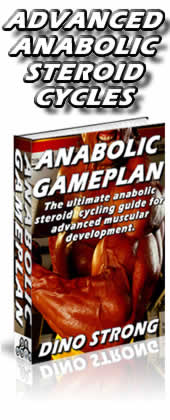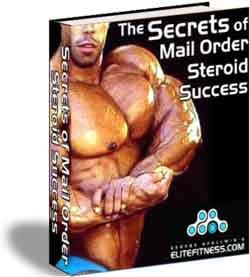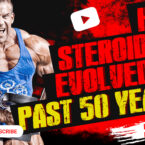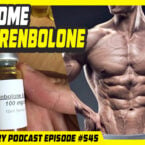Sign up to Get FREE Steroids, SARMS, Peptides eBooks
In this weeks EliteFitness.com Bodybuilding news, I\'m pleased to publish my friend Tom Venuto\'s article Killer Abs! Old-School Bodybuiling-Style.
In this free report right here, Tom\'s got a huge confession, here\'s what he wrote:
"I have a confession to make. This might shock you. Are you ready? Don’t hate me. Okay, here it is:"
"I don’t train my abs very much. Once a week for about 15 – 20 minutes. That’s it. Seriously – no kidding. I work my abs like any other small body part, maybe even less."
Take a look at Tom\'s pic below on the left. I don\'t know about you, but I would kill to have abs like his. And this week, Tom will tell us all his ab building secrets. Enjoy!
Before Tom tells you his ab secrets, here\'s just a little about Tom.
Since 1989, Tom Venuto has been involved in the fitness industry as a personal trainer, success coach, nutrition consultant, health club manager, publisher and freelance writer. Tom has written over 170 articles and has been featured in IRONMAN magazine, Muscular Development, Muscle-Zine, Exercise for Men and Men\'s Exercise.
 Tom\'s educational background includes a B.Sc. degree in exercise science and he is also a "Certified Strength and Conditioning Specialist" (CSCS) from the National Strength & Conditioning Association (NSCA), the most prestigious personal trainer certification in the world. Tom is a lifetime bodybuilder and has won numerous competitions including three state and three regional titles, and runner-up at the Natural Mr. USA and Natural North America. Tom Venuto\'s e-book, Burn The Fat, Feed The Muscle, is rated by Click Bank as the #1 fitness e-book and the #1 diet e-book on the Internet, with users in 107 countries.
Tom\'s educational background includes a B.Sc. degree in exercise science and he is also a "Certified Strength and Conditioning Specialist" (CSCS) from the National Strength & Conditioning Association (NSCA), the most prestigious personal trainer certification in the world. Tom is a lifetime bodybuilder and has won numerous competitions including three state and three regional titles, and runner-up at the Natural Mr. USA and Natural North America. Tom Venuto\'s e-book, Burn The Fat, Feed The Muscle, is rated by Click Bank as the #1 fitness e-book and the #1 diet e-book on the Internet, with users in 107 countries.
For Less Than the Cost of One Personal Training Session, You Can Now Learn The Inside Information That The World\'s Best Bodybuilders and Fitness Models Have Kept Shrouded in Secrecy For Decades!
For the complete inside story on Burn The Fat, Feed The Muscle and to get a very special deal (in the next 72 hours only) just for the readers of EliteFitness.com News, then you owe it to yourself to learn more.
KILLER ABS! OLD-SCHOOL BODYBUILING-STYLE
In 8 Easy Lessons... Plus My Favorite “Killer” ab routines
By Tom Venuto
I have a confession to make. This might shock you. Are you ready? Don’t hate me. Okay, here it is:
I don’t train my abs very much. Once a week for about 15 – 20 minutes. That’s it. Seriously – no kidding. I work my abs like any other small body part, maybe even less.
Now, you’re probably wondering, how can you possibly get “Killer Abs” with only one ab workout a week?
Well, if you already own my Burn The Fat, Feed The Muscle System, or even if you’ve simply followed my articles and newsletters closely for a while, you already know the answer...
Lesson #1 in old-school style killer abs is: Get rid of the fat or you’ll never see your abs, no matter how often you train, no matter how many reps you do or no matter what exercises you do
LISTEN: AB TRAINING DOES NOT BURN FAT OFF YOUR STOMACH!
This is probably the biggest misconception that people have about exercise today and I don’t think the general public is EVER going to get it. The myth that ab training burns fat off your abs is so pervasive that I suspect it will never die and simply continue to be passed down from generation to generation.
The truth is, getting six-pack “killer” abs has almost nothing to do with training. It has everything to do with low body fat.
Ironically, I believe the abdominal muscles are quite easy to develop; much, much easier than building an 18 or 19 inch arm, a 315 pound bench, a 400 pound squat, or a wide, V-shaped back, for example.
Some people might argue that I was just blessed with good genetics in the ab department, which may be true, but based on my experience with others who have less favorable genetics, I still believe that developing the abdominal muscles is easy. The hardest part is getting your body fat low enough for your abs to show.
Most people grossly over train their abs. Training your abs daily or even every other day for hundreds or thousands of reps is totally unnecessary and a complete waste of time.
AB EXERCISES DON’T BURN FAT!!!!!!
You lose fat with nutrition and cardio. If you want to see your abs, tighten up your diet and do more cardio! The bottom line is, if your abs are covered with a layer of fat, you won’t be able to see them, no matter how much ab exercise you do! If you need help with fat loss, here\'s a link to check out my Burn The Fat, Feed The Muscle fat burning system.
Lesson #2 in old-school style killer abs is: The same old basic ab exercises that have been around for years, STILL work – and that means CRUNCHES!
“Core training” and “functional training” are the “IN” things today. Devices and modalities such a stability balls, medicine balls, core balls, ab wheels, kettlebells, functional exercises, and so on, are all valuable tools, but for the most part they simply represent what is trendy and fashionable in fitness training today.
“Core” and “functional training” come largely from the sports world, and if you’re a competitive athlete, martial artist, golfer, tennis player, or you play any sport recreationally, this type of training is worth looking into.
However, for pure “cosmetic” ab development, there is nothing new under the sun. The “old school” methods are as valid as ever. And that starts with crunching exercises. Why? Because the prime function of the abs is to flex the spine and shorten the distance between the sternum and pelvis – which is exactly what crunching exercises do.
Very recently, a well-known ab training “guru” wrote in one of his books that “Crunches are worthless.” Funny how things change. It wasn’t so long ago that powerlifter and exercise physiologist Fred “Dr. Squat” Hatfield wrote, and I quote, “Crunches are the Cadillac of abdominal exercises.”
So what’s the deal? Should you crunch or should you ditch this “old” exercise in favor of all the “new stuff?” The truth is, there’s a happy medium! Crunches are not “worthless” by any means, but they’re also not the only way to train abs. You can and should incorporate a wide variety of crunch variations into your program and also include some functional work and stability ball work which will help develop your core musculature and allow you to work your abs through a larger range of motion.
Despite all the new and trendy ab workouts and equipment being promoted these days, the good old crunch is the oldie but goodie I always come back to time and time again. I’ve used crunches and their many variations in almost all my training routines for years.
The best Crunch variations (upper abs)
1. Feet on floor reach through crunch
2. Feet on floor, hands crossed over chest crunch
3. Feet on floor hands behind head crunch
4. Feet on bench hands behind head crunch
5. Feet in air hands behind head crunch
6. Feet in air, hands behind head, pull in knees, touch elbows
7. Weight on chest crunch
8. Weight behind head crunch
9. Weight held at arms length above chest crunch
10. Stability ball crunch, bodyweight
11. Stability ball crunch, with resistance
12. Weighted supine crunch machine (such as Icarian Ab Bench)
|
Important: For the next 72 hours only, EF Members get a very special deal! |
Lesson #3 in old-school style killer abs is: Crunch with cables too.
Crunches performed off the floor are good. Cable crunches might be even better. Unfortunately, I don’t think I’ve seen more than one out of fifty people perform the exercise properly.
Cable crunches can be performed seated, standing or kneeling. My favorite is kneeling cable crunch. Performed properly, this is an AB-solutely KILLER exercise!
KNEELING CABLE CRUNCH
Most people perform the cable crunch like they were bowing. They bend only at the hips brining the elbows straight down to the floor, while the entire spinal column stays in a straight line. This does not cause the abs to contract through their full range of motion, it only gives you an isometric contraction of the abs, while bringing the hip flexors strongly into play.
Proper form on the kneeling cable crunch is a curling motion, almost like a carpet being rolled up. Another way I like teach this exercise is to have a trainee visualize that a log is in front of them about a foot off the floor, and I ask them to imagine they are wrapping their torso around the log, rounding the back over and curling the spine in a circular range of motion, curling the elbows over and around the log and back in towards the knees.
Also, some people perform this facing away from the weight stack, which is one acceptable variation. I prefer facing towards the weight stack and holding a rope with my hands held at the top of my head/forehead.
Master the proper form on this exercise and you’ll see your abs start coming into focus at an alarming rate.
EliteFitness.com visitors can use the links here and 4RX.com coupon code 1177452535 to save an extra 10% on all orders. Apply this code in the \'coupon code\' field when you checkout. 4RX.com also sells all the ED drugs (generic Viagra, generic Cialis, and generic Levitra) at the lowest prices online. You can even get a multi-pack of all three. They have the anti-estrogen drugs Anastrozole (Arimidex), Letrozole (Femara), Clomiphene (Clomid) and Tamoxifen (Nolvadex). They have muscle relaxants, Finasteride (Propecia) and Dutasteride as well as many others of interest to bodybuilders. [Click here to check pricing.]
[Click here to check pricing.] Check out George\'s listing of all the reputable online pharmacies. |
Lesson #4 in old-school style killer abs is: After you’ve developed a substantial level of abdominal strength and coordination, learn how to do this advanced killer ab exercise: Hanging leg raises from the chin up bar
If there’s any “secret weapon” in my ab training arsenal – the one exercise I’ve ALWAYS turned to when I wanted major results is the hanging leg raise, and its “younger brother,” the hanging knee up. These can be performed hanging by your hands from a chin up bar, although it’s much easier with “ab slings” because grip strength is no longer the limiting factor.
Bill Phillips once made fun of this exercise in his magazine. He showed a picture of his Brother Shawn dangling precariously from the ab slings in a mocking fashion. I’m not sure why he blasted this movement, and Shawn certainly has a six-pack rack with the best of them. But personally, I think the hanging leg raise and knee up are two of the best ab exercises in existence.
I think the problem is that this exercise is so difficult that most people can’t do them properly. Usually the first time you attempt a hanging leg raise from the chin up bar (with no back support behind you), you swing uncontrollably from front to back. So most people try these once or twice and then give up. Like anything else, practice makes perfect. Hanging leg raises are a very advanced and very difficult movement. Don’t expect to do them like a pro on your first try – and don’t even try them if you’re a beginner.
If you’re a beginner, the best way to develop the strength necessary to do these properly is to start on the support leg raise. That’s the piece of equipment found in almost every gym that has the pad for your forearms and elbows to support your body weight and a back support behind you. Start with support knee ups, then progress into support leg raises with the legs nearly straight. It’s important to use a full range of motion on this exercise and get your knees high up in front of the chest because the lower portion of the range of motion is largely initiated by the hip flexors.
Once you’ve mastered the support leg raise, then you can move on to the hanging knee up and ultimately to the hanging straight leg raise. When you master the hanging leg raise, there’s an even higher level: You can begin to superset from the hanging leg raise (until fatigue) into the hanging knee up. Once you’ve reached the point where you can perform three supersets of 15 to 25 reps of hanging leg raises to hanging knee ups with STRICT form, I guarantee you will have amazing abdominal development (provided of course, that your body fat is low enough).
Lesson #5 in old-school style killer abs is: Yes, you can train your lower abs
One of the biggest controversies in ab training is the question of whether you can “isolate” your upper and lower abs. There are experts who swear you can, and experts who swear you can’t. If someone wants to get technical and split hairs, then it’s true – you CAN’T isolate lower and upper abs. The word “isolation” is somewhat of a misnomer because muscles work in conjunction with other muscles at all times.
For example, a bench press is often called a “compound” exercise because the pecs are heavily assisted by the triceps and deltoids, while a dumbbell flye is usually referred to as an “isolation exercise” because it “isolates” the pecs more. However, the pectorals do not and cannot work in complete isolation from the triceps and deltoids; there is simply a smaller degree of involvement from the assisting muscles in the flye exercise. Therefore, the flye is a pec "isolation" exercise, relatively speaking, but not literally speaking.
The same is true of the abs. You can’t completely isolate the lower from the upper abs or the abs from the obliques, but you CAN put greater emphasis on the lower or upper abs depending on the exercise you select.
The abdominals are a unique muscle. They are not a single long muscle belly like the biceps, which has continuous fibers running the entire length from origin to insertion. The ab muscles have a tendinous band in between each section. This is what gives the abs their segmented, “six pack” appearance.
Each segment of the abs flexes a portion of the lumbar spine and or pelvis. The lower abs are the part responsible for the flexion of the lower lumbar vertebrae and backward rotation of the pelvis. The upper abs are responsible for the flexion of the upper part of the lumbar spine.
The practical application of this information is simple: Exercises that draw the lower body towards the upper body, such as reverse crunches, hip lifts, and leg raises, emphasize the lower abs. Exercises that draw the upper body towards the lower body, such as crunches, emphasize the upper abs (but neither completely isolates one or the other).
One last tip: Because most lower ab exercises require more coordination and stability (they’re harder), do your lower abs first most of the time.
The best lower ab exercises
1. Support knee ups
2. Support leg raise
3. Hanging knee up
4. Hanging leg raise
5. Reverse crunch
6. Incline reverse crunch
7. Stability ball reverse crunch
8. Hip lift
9. Bent knee leg raise/hip lift combo
10. Incline hip lift
Lesson #6 in old-school style killer abs is: Avoid weighted side bends, which thicken the waist. Instead, opt for body weight elbow to knee twisting crunches, twisting hanging knee ups and side crunches to develop your obliques
Which would you rather have: (A) a tiny waist that narrows down from broad shoulders and a V-tapered back or (B) A muscular, but thick, wide and blocky waist.
Yeah – I picked “A” too. So do most other people. However, not a day goes by in the gym when I don’t see people doing side bends with heavy dumbbells. I could NEVER understand why people would ever want to do these. I suppose, once again, people mistakenly think they’re burning fat with this exercise.
The way to develop a beautiful and symmetrical physique is to create an illusion: Broad shoulders and a V-shaped torso must flow down into a tiny waist. You want to increase the size of your lats and deltoids (yes that includes you ladies too), while decreasing the size of your waist. Anything that makes your waist bigger will destroy your shape. Weighted side bends can make your waist thicker and wider by developing the muscles on the sides of the waist known as the obliques.
There’s a big difference between sports training and bodybuilding (or cosmetic) training. Unless you’re an athlete with a need for a strong, thick trunk musculature, I’d suggest avoiding weighted side bends and all other weighted oblique exercises completely.
Instead, simply do twisting elbow to knee crunches, twisting hanging knee ups, and side crunches only with your body weight. These exercises tend to hit the diagonal fibers of the obliques a little higher up on the waist, not the portion of the obliques on the lower, lateral area of the waist.
Lesson #7 in old-school style killer abs is: Sit ups and leg raises are mediocre exercises at best
I’ve found that all varieties of sit-ups aggravate my lower back. Fifteen years ago I sustained a rupture of my fourth lumbar disc (L4) so severe that a neurosurgeon told me that I could forget about bodybuilding, I should never lift more than 40 pounds and I would eventually have to get surgery.
Despite the surgeon’s grim prognosis, I rehabilitated my own back, but to this day, I still have a sensitive lumbar area. Doing the wrong abdominal exercises always brings back the pain almost instantly. I look at this as a positive thing because it has taught me a lot about what’s really happening during certain ab exercises. It has also prompted me to modify my routine to avoid certain troublesome exercises that pull on the lumbar spine more than develop the abs.
Most people think sit-ups are primarily an ab exercise. They’re not. Sit-ups work the abs, but largely in an isometric fashion. Sit ups are an “integrated” exercise that work the abs and hip flexors, but the hip flexors do most of the work (especially the way most people perform them – quickly, with the feet anchored, and with extra weight).
The psoas muscle, which is the primary hip flexor involved in the sit-up, originates on the lower lumbar vertebrae and inserts on the lesser trochanter of the femur (the top of your thighbone). Because the psoas is so heavily involved in the sit up and because the psoas is attached to your lumbar spine, sit ups cause a tremendous amount of “pull” to occur on your lower back.
Visualize an imaginary hand reaching through your stomach, grabbing a hold of your spine, and pulling on it as if the hand were trying to yank your spine right out the front of your stomach. That’s essentially what’s happening when you do sit ups or roman chair sit-ups. Ditto for supine full range straight leg raises.
You might say, “But I feel it working – I feel the burn!” Yes, but your abs aren’t contracting dynamically through their full range of motion, they’re contracting isometrically – and that causes the burn. It’s similar to when you hold a dumbbell out at arms length in front of you for as long as you can. Before long your shoulder is burning like crazy to the point where you cant even hold the dumbbell any longer. You get great burn from this, but that’s not how you’d train your shoulders is it? So why would you train your abs that way?
Sit-ups have made somewhat of a comeback lately, as the sports training and core training "gurus" claim that the hip flexors should be integrated into your ab routines. Unless you’re an athlete with a specific need for strong hip flexors, you have no history of lower back injury, and you already have a strong lower back and strong abdominals, forget about using sit-ups as your primary exercise. They’re a mediocre exercise at best, and for some people with injuries (even “old” injuries like I have), sit ups are contraindicated completely.
Now... I know what you’re thinking: You know someone who does a zillion sit ups a day, they have great abs and have never had a back injury. Well, first of all, if the individual has strong abs and lower back and no pre-existing injuries, sit ups done with good form won’t necessarily cause an injury. Second, as I said earlier, developing the abdominal muscles is not difficult. To a certain degree, you can develop the ab muscles from almost any ab exercise – even nothing but sit-ups or isometric exercises.
When I was back in my “human guinea pig” days, I once went over a year without doing any ab exercises whatsoever. After I dieted down to about the mid single digits in body fat, there were my abs, looking EXACTLY like they did the year before when I was training them two or three times per week. Knowing this, I’m often tempted not to train abs at all, except that I know strong abs are important for stability and injury prevention.
Just because someone has great abs doesn’t mean they’re using the best routine. Part of it may be genetics, but mostly it just means they have low body fat! Let me drive this point home AGAIN - Having “killer six-pack abs” has less to do with training than with low body fat. Everyone has a six pack! Most people just can’t see theirs yet.
Lesson #8 in old-school style killer abs is: When you reach the advanced level, begin using supersets, tri-sets and giant sets (circuit training) in your ab workouts.
One of the fastest ways I know of to develop the abs is to use supersets, tri sets, giant sets or circuit-style ab training, where you perform two or more exercises in a row without stopping. Coincidentally, this is also a great way to get your workouts finished faster. This is an advanced form of training and you’ll need time to build up the strength and endurance necessary to use these techniques.
A SUPERSET is where you perform two exercises in a row without stopping. For example, you might do a reverse crunch for 15-25 reps, then without any rest whatsoever, go directly into a regular crunch for 15-25 reps, for a grand total of 30 – 50 reps non stop. That’s one superset. You would then take your usual rest interval and repeat for the desired number of sets.
TRI-SETS are the same as supersets, except you perform three exercises in a row without stopping. For example, you might do the reverse crunch, hip lift, and regular crunch all in a row with no rest between exercises.
GIANT SETS are when you perform four or more exercises in a row without stopping. Some people call this circuit training, although performing “circuit training” for a single body part is generally referred to more often as “giant setting.”
PART II: My Favorite killer ab Routines
The best way to finish up an ab article is with some routines, don’t you agree? All of the following routines are actual programs that I have used and/or am currently using now. I have tested them and they’re all KILLER!
I mentioned earlier that I only train my abs once per week. Depending on what type of split routine you\'re on, you could easily perform these routines twice per week. More than two ab workouts per week is not necessary.
Basic straights sets routine
1. Reverse crunch 3 sets X 15-25 reps
2. Floor crunch 3 sets X 15-25 reps
3. Elbow to knee twisting crunch 3 sets X 15-25 reps
(or side crunch)
Advanced straight sets routine
1. Incline reverse crunch 3 sets X 15-25 reps
2. Kneeling cable crunch 3 sets X 15-25 reps
3. Hanging twisting knee up 3 sets X 15-25 reps
Heavy-light routine
Select three ab exercises, all using resistance, for example:
1. Kneeling cable crunch
2. Weighted stability ball crunch
3. Supine Ab crunch machine
Perform three sets of each exercise. Every other workout, change repetition range and resistance as follows:
Workout A: (light) 15-25 reps, tempo 1011
Workout B (heavy) 8-12 reps, tempo 2022
Tempo (seconds)
2 eccentric
0 pause in stretch position
2 concentric
2 pause in contracted position
Superset routine
1. Hanging knee up 2-3 sets X 15-25 reps
superset to:
2. Kneeling cable crunch 2-3 sets X 15-25 reps
3. Reverse Crunch 2-3 sets X 15-25 reps
superset to:
4. Crunch with feet on bench 2-3 sets X 15-25 reps
Tri-set routine
1. Hanging Leg raise 3 sets X 15-25 reps
no rest, go directly to:
2. Hanging Knee Up 3 sets X 15-25 reps
no rest, go directly to:
3. Weighted supine crunch 3 sets X 15-25 reps
rest 60 seconds, repeat for a total of three tri-sets
The Ultimate Killer Ab Routine (giant set)
1. Hanging straight leg raise 15-25 reps
2. Hanging knee ups 15-25 reps or as many as possible
3. Hip lift 15-25 reps
4. Reverse crunches 15-25 reps
5. Weighted supine crunch 15-25 reps
6. Bodyweight crunches 15-25 reps
Each sequence of six exercises is one giant set. Rest 60 – 90 seconds after you finish exercise #6, then repeat for a total of three circuits. (if you can get through three circuits of this routine with strict form, including hitting 25 strict leg raises and 25 knee strict knee ups, you are in elite company) Good luck!
Conclusion
These eight principles and the sample routines are just the tip of the iceberg in my ab training arsenal but it’s all I have time for in this newsletter. However, this should be more than enough ammo for you to begin an all out assault on your abs.
If you employ these techniques in conjunction with a supportive fat loss nutrition and cardio program such as Burn The Fat, Feed The Muscle, your abs will come in so fast it will almost scare you!
If there’s enough interest, then maybe I’ll do a part II to this article, or I may even publish a full length, photographically illustrated course on ab training. In the meantime, get to work on those ab slings, crunch away and send me a picture of you and your new six pack rack - because it’s on its way!
[sc:signoff-std] 
 "I wish I had Beyond Steroids 20 years ago. Easy reading and opinions on what fits my needs." ~Phil Hernon, IFBB Pro
"I wish I had Beyond Steroids 20 years ago. Easy reading and opinions on what fits my needs." ~Phil Hernon, IFBB Pro
With Beyond Steroids, you\'ll gain 30lbs of lean muscle mass and drop your bodyfat into the low single digits or get Triple Your Money Back - GUARANTEED!
Beyond Steroids is about how you can learn to use all the world\'s newest, rarest and most effective bodybuilding drugs... The drugs never before written about! And discover radical cycles to combine the new stuff with the "classic anabolic steroids" in ways most Pro Bodybuilders don\'t even understand.
Your tremendous muscular gains will be the envy of elite bodybuilders worldwide and have scores of women staring in disbelief at your hard, lean, ripped muscular development. Use this link to go Beyond Steroids! ![]()


 4RX.com
4RX.com XL Rx
XL Rx







